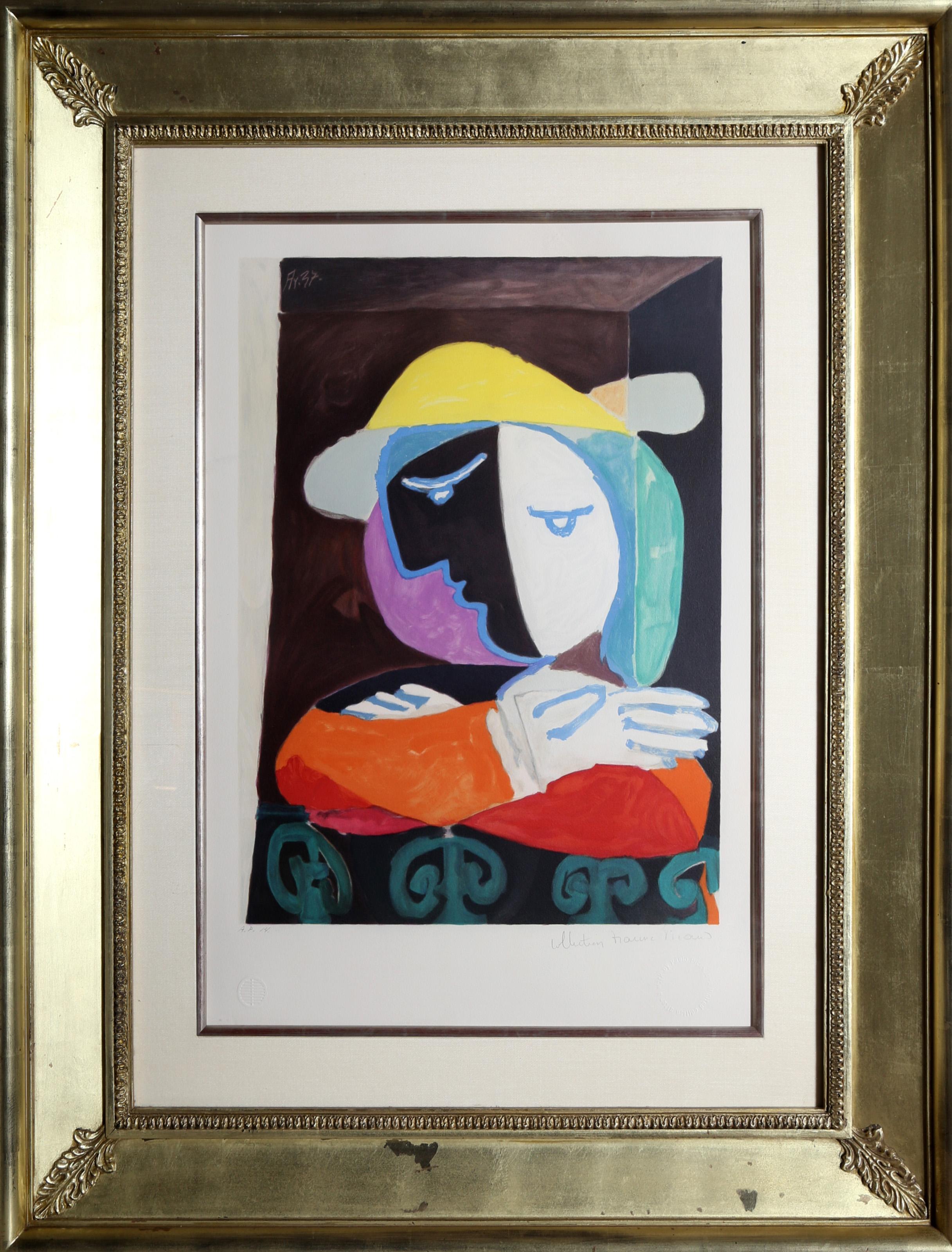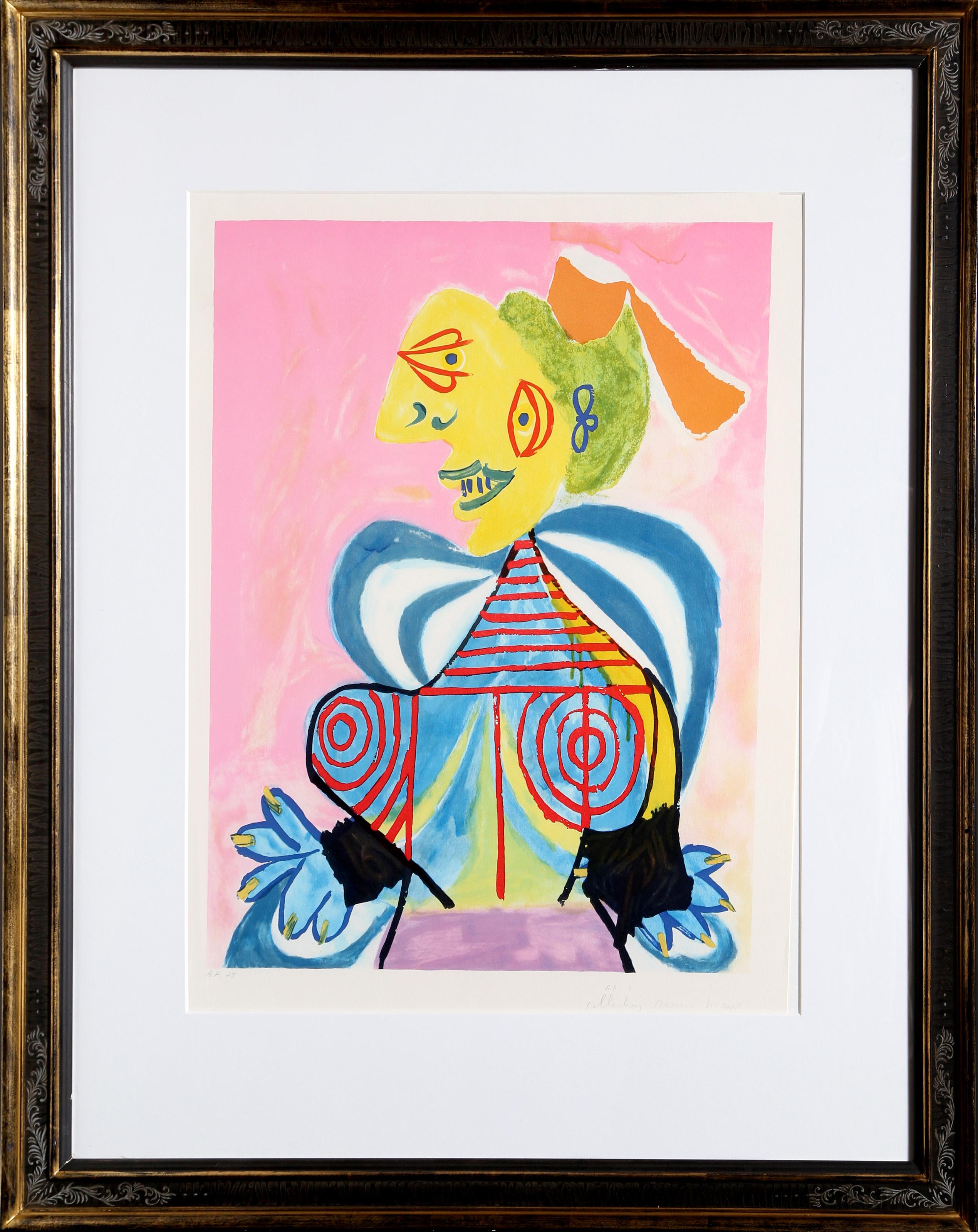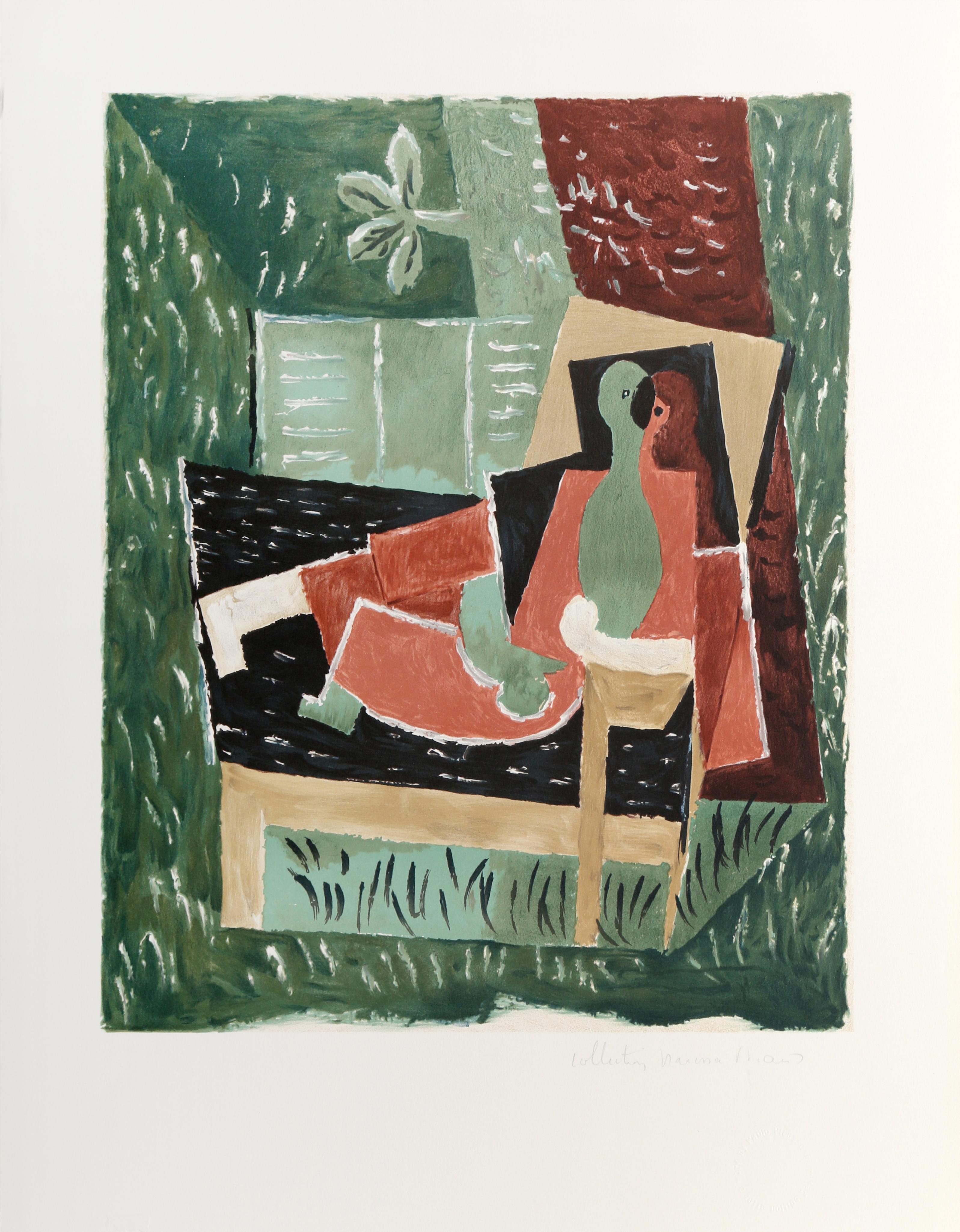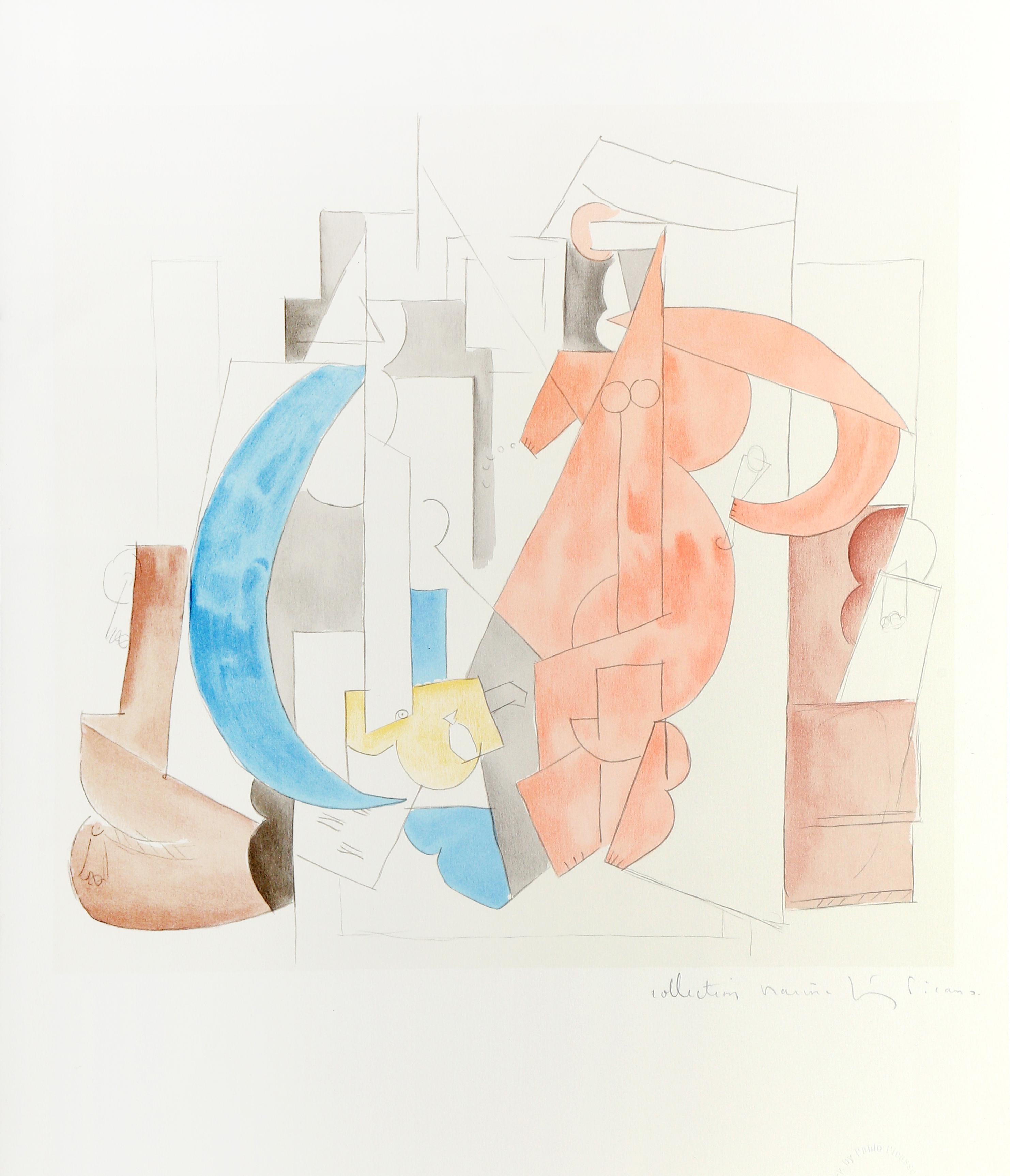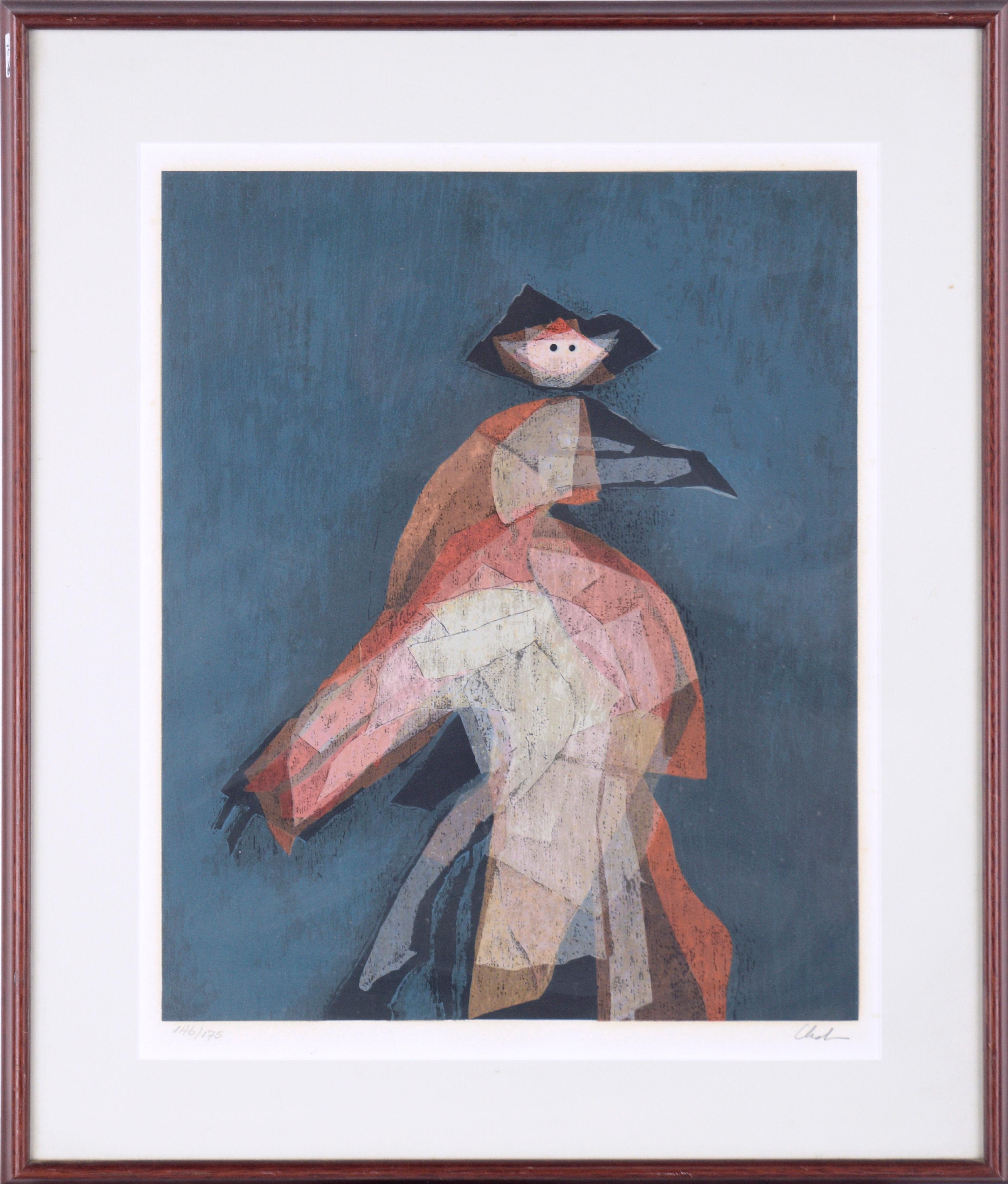Items Similar to Figural Abstract Mid Century Modern Lithograph Portraits, Judaica, Jewish Print
Want more images or videos?
Request additional images or videos from the seller
1 of 10
Rita GombinskiFigural Abstract Mid Century Modern Lithograph Portraits, Judaica, Jewish PrintMid 20th Century
Mid 20th Century
About the Item
This is a proof print and is unsigned. it has Jewish Hebraic motifs, a menorah with a Jewish star, a mezusah or megilla scroll by this talented Jewish woman artist. Her whole life long, through the births of two children, the deaths of two husbands, three wars and across two continents, Rita Gombinksi has painted.
Her studio, now an apartment in the Irving Cypen Tower at the Miami Jewish Home and Hospital for the Aged, nearly brims with works -- in closets, leaning against walls and stacked in boxes. Some date to just months ago. Some are seven decades old. There is one large collage that was completed during the fall of Saigon. On a dresser is a portrait of a young Gombinski and her second husband as newlyweds, done in her intricate abstract style. Works in progress are spread across an old dining room table, now used as a kind of easel.
Rita Gombinski sits among some of her drawings that she is sorting through. Despite this breadth and consistency, it is with some bemusement that Gombinski, who turns 88 this month, takes in a renewed interest in her work.
"I'm trying to be organized," she says as she searches through one of dozens of albums containing small works and photographs of works sold. "Slowly but surely I'm going to put things together. It's not easy because I've done so much."
Gombinski, who owned the Gombinski Gallery with her husband, Mendel, at 900 Lincoln Rd. in Miami Beach, for a decade in the 1980s and 1990s, and two other galleries in New York and Israel, is now the artist-in-residence at the Miami Jewish Home, a title she announces sheepishly. "I donated so much of my art that I have been called the artist-in-residence here," she says of approximately 150 paintings she gave to the home.
She has also donated paintings to the Bass Museum, University of Miami and organizations in Israel, where she lived during the 1970s. Gombinski's work, done mostly in watercolor but also crayon and ink, evolved from her most influential teacher, William Baziotes, an abstract expressionist and surrealist whose works are in the Guggenheim collection. Perhaps more influential, she said, were the patterns from her family's textile company. Quite often she starts by painting a pattern, then inserts a figure.
Gombinski grew up in the Bronx and can still vividly recall her first recognized work: a painting of a cat done in elementary school. In her senior year in high school, she jokes, she received her first official critique after sending an article and illustration from the high school paper to famed New Yorker critic Alexander Woollcott, whose yellowing note card she keeps in a journal:
An abstract painting by Rita Gombinski depicts the artist and her second husband. "I think you have considerable promise -- even if you don't yet know the difference between infer and imply," he wrote, referring to her misuse of the words.
She went on to marry her high school sweetheart, a textile engineer, and in about 1943 moved to South Carolina. He joined the Air Force to avoid being drafted into the army and they moved to Sarasota. But within months he was killed in a training flight. At the time, Gombinski was three months pregnant with her daughter.
Back in New York, living in a veterans' project for widows, she continued painting and raised her daughter. When her father's second cousin came to America after surviving a Russian concentration camp, she decided to remarry.
"After four years, I was ready for another life," she said. A year later, her son was born and in 1952, she received her bachelor's degree in fine arts from the Pratt Institute. She later earned a master's in art education from New York University.
The new family opened their first gallery near Soho. But when Gombinski's father died, they moved to Florida. After several years, she and Mendel moved the family to Haifa, Israel, where they opened a second gallery. When Steven graduated from high school, they returned to Florida and opened their Lincoln Road gallery, which featured not only Rita's work, but works from Israelis and other young artists.
In the 1990s, when Mendel came down with Alzheimer's, Gombinski struggled to maintain the gallery, but found caring for her husband overwhelming. In 1996, he was moved to the Miami Jewish Home. Two years after he died, in 2001, Gombinski moved into the home's independent living building.
While she apologizes repeatedly for the clutter of art, she concedes that it is this art, and the selling and managing of it that has kept her going.
"If it wasn't for all this," she said, "I would have gone bananas."
- Creator:Rita Gombinski (1919 - 2015, American)
- Creation Year:Mid 20th Century
- Dimensions:Height: 20 in (50.8 cm)Width: 28 in (71.12 cm)
- Medium:
- Movement & Style:
- Period:
- Condition:
- Gallery Location:Surfside, FL
- Reference Number:
About the Seller
4.9
Platinum Seller
These expertly vetted sellers are 1stDibs' most experienced sellers and are rated highest by our customers.
Established in 1995
1stDibs seller since 2014
1,548 sales on 1stDibs
Typical response time: 1 hour
- ShippingRetrieving quote...Ships From: Surfside, FL
- Return PolicyA return for this item may be initiated within 3 days of delivery.
More From This SellerView All
- Large Venezuelan Modernist Lithograph "The Balcony #3" Color PrintBy Marius SznajdermanLocated in Surfside, FLMarius Sznajderman was a painter, printmaker and scenic designer living and working in the United States. Born in Paris, France in 1926 his Jewish parents had migrated to France from Poland in 1923. In November 1942 the family fled Nazi-occupied France for Spain before settling in Caracas, Venezuela. He attended the School of Fine Arts in Caracas where his teachers included illustrator Ramon Martin Durban, scenic designer Charles Ventrillon-Horber and painter Rafael Monasterios. and immigrated to the United States in 1949, where he received a Bachelor of Fine Arts and Master of Fine Arts from Columbia University in New York. He settled in Hackensack, New Jersey, where he lived and had a studio for more than 50 years before moving to Amherst, Massachusetts in 2015. His work, which includes painting, prints and collages, as well as set designs, is in more than 45 museum and public institution collections in the United States, Latin America and Israel. He held more than 40 solo exhibitions at galleries and museums and participated in more than 75 group shows around the globe. He helped found the Taller Libre de Arte, an experimental workshop for the visual arts, sponsored by the Ministry of Education. The Taller Libre de Arte was a center for young artists to work and to meet with critics and intellectuals to discuss avant-garde ideas and artistic trends from Europe and Latin America. Among the notable artists who participated in the Taller Libre de Arte were Ramón Vásquez Brito, Carlos González Bogen, Luis Guevara Moreno, Mateo Manaure, Virgilio Trómpiz...Category
20th Century Modern Figurative Prints
MaterialsLithograph
- Mystic Cafe, Signed Aquatint Etching California Woman ArtistBy Susan HallLocated in Surfside, FLSusan Hall lives and works in Point Reyes Station, California, a town in the heart of the Point Reyes National Seashore. This pristine wilderness area is dominated by a mosaic of bay...Category
1970s American Modern Abstract Prints
MaterialsEtching, Aquatint
- Michael David, Mugual Indian Star Abstract Expressionist Color Etching PrintBy Michael DavidLocated in Surfside, FLMichael David (b. 1954) Hand signed, Prestige Art blind stamp; edition of 45; 1993 Color Etching on Arches Buff "The Mugual Series" Printed by the artist with master printers Sylvia Roth and Mary Seibert at Hudson River Editions and published by Prestige Art Ltd., Mamaroneck, New York. 22 X 18 framed Michael David Singer; born 1954, is an American painter. Born in Reno, Nevada, David's family relocated to Brooklyn, New York, where he was raised. He attended SUNY Fredonia for one year and in 1976 received a B.F.A. from Parson's School of Design. Michael David is classified as an abstract painter, best known for his use of the encaustic technique, which incorporates pigment with heated beeswax. He is also known for his works in mixed-media figure painting, photography and environmental sculpture. His work is included in the permanent public collections of the Metropolitan Museum of Art, the Guggenheim Museum, the Jewish Museum in New York, the Museum of Contemporary Art in Los Angeles, and the Los Angeles County Museum of Art, among others. In 1976 David, erotic photographer Roy Stuart and Fredonia friend Richie Stotts formed a band called The Numbers, with David on bass. The group was a fixture in New York's early punk rock music scene, playing in clubs alongside punk pioneers Television, Blondie and the Ramones. David also played bass with punk innovators Jerry Nolan of The New York Dolls, Cheetah Chrome of The Dead Boys, Marky Ramone, Peter Gordon, David Van Tieghem and the free-improvisation noise music group Borbetomagus. In 1977, The Numbers were approached by impresario Rod Swenson, who was seeking musicians to form a backing band for singer Wendy O. Williams, whose radical persona he sought to exploit as punk music and performance art. The Numbers became The Plasmatics but the attention David began to gain as an important voice in the art world caused him to leave the band to pursue his burgeoning painting career. David's first one-man show was in 1981 at the historic Sidney Janis Gallery. That year he was awarded a Guggenheim Fellowship, at the time the youngest artist ever to do so, and in 1982 was awarded an American Academy of Arts and Letters prize. He went on to exhibit at galleries worldwide and was represented by Knoedler & Co. for the next 25 years. David is best known for using the encaustic technique of painting, which uses pigment combined with heated beeswax. David built his early career on abstraction and religious iconography, which formed the bulk of his output until 1999. Since then he has also experimented with representational painting and traditional photography. In 2000, he developed the "Chortens" and "Populations" series, about which prominent art historian and critic Donald Kuspit writes: "They are enigmatic works, all the more so because of the way their innumerable details form singularly monumental, intimidating wholes. Dense yet delicate, awesome yet intimate, they convey the fragility as well as grandeur of sheer being. Layer upon layer of paint piles up like layer upon layer of coral, but the textural result is more epic, not to say startling, than any coral island, and virtually any other existing abstract expressionist painting (upon which they are stylistically founded)." In 2001, David developed bi-lateral neuropathy due to being poisoned by gases released by overheated beeswax used in the encaustic process. The disease left him with partial paralysis of his legs, slowing the production of his painting for a number of years. That year, David began painting one of his best-known series, the "fallen Toreadors", inspired by 19th century French Realist painter Édouard Manet's "The Dead Toreador" of 1864. In 1993, David experimented at the "20x24" Polaroid studio in Manhattan, which resulted in a series of portraits of playwright Edward Albee and of friend Jackie Gross, which would become the ongoing "Jackie" series of mixed-media works. When neuropathy rendered him unable to paint during 2003, he returned to the 20x24 camera and shot large-format Polaroids inspired by Caravaggio; nude men and women dressed as Toreadors, and religious imagery. In 2002, David began to develop The Greenhouse Project, an evolving "architectural construct" based on historical American Antebellum greenhouses built using the actual glass negatives sold to starving farmers in the post-American Civil War South. David has indicated that each greenhouse will, through the display of photography and use of social networking, create a forum and exhibit for ideas and artifacts related to civil and human rights; the specifications of each greenhouse particular to the community in which each is built. David's work was reviewed in Artforum and Art in America, and is considered one of the last links to the New York School of painting. David may be the most innovative master of immediate surface since the abstract expressionists. He has acknowledged his debt to Abstract Expressionism, but he has transformed it. Where the abstract expressionist paintings of the forties and fifties seem like modern cave paintings, as their crude, unfocused, often meandering, turbulent painterliness suggests, and as such to reinstate prehistory, David seems to turn the cave into a temple, as his more considered, concentrated, indeed, dense, contemplative painterliness indicates, so that his paintings have the aura of post history. SELECT GROUP EXHIBITIONS 2010-2011 “Post Mammalian Tension, Michael David & Scott Browning”, Bill Lowe Gallery, Atlanta, GA 2006 “Unspoken Connections,” The Lowe Gallery, Santa Monica, CA 2004 The Lowe Gallery, Atlanta, GA 1999 “Waxing Poetic: Encaustic Art in America,” Montclair Art Museum, Montclair, NJ “Forty Years of American Drawings,” Raab Galerie, Berlin, Germany 1997 “Michael David and James Hyde,” Margulies Taplin Gallery, Coral Gables, FL 1996 “Different Sides: Drawings/Photographs/Prints/Paintings/Sculpture,” Knoedler and Company, New York, NY 1994 “Michael David: Paintings / Nicholas Pearson: Sculpture,” Margulies Taplin Gallery, Boca Raton, FL 1991 “Working with Wax: Ten Contemporary Artists,” Tibor de Nagy Gallery, New York, NY 1989 “Projects and Portfolios: the 25th Print National,” The Brooklyn Museum, Brooklyn, NY “Important Works on Paper,” Meredith Long and Company, Houston, TX “New Editions,” Pace Prints, New York, NY 1988 “Golem! Danger, Deliverance, and Art,” The Jewish Museum, New York, NY 1987 “Monotypes,” Pace Editions, New York, NY “Working in Brooklyn / Painting,” The Brooklyn Museum, Brooklyn, NY “Art Against AIDS,” benefit exhibition Knoedler and Company, New York, NY “Jewish Themes: Contemporary American Artists,” Spertus, Chicago, IL 1986 “First Impressions: Recent Monotypes by 15 Artists,” Allan Frumkin Gallery, (Charles Arnoldi, Pat Steir etc) “Saints and Sinners: Contemporary Responses to Religion,” De Cordova Museum, Lincoln, MA “Jewish Themes: Contemporary American Artists,” The Jewish Museum, New York, NY “Public and Private American Prints Today,” Brooklyn Museum, Brooklyn, NY 1985 “A Decade of Visual Arts at Princeton: 1975-1985,” The Art Museum, Princeton University, Princeton, NJ 1984 “Cunningham Dance Benefit,” Leo Castelli Gallery, New York, NY (Robert Rauschenberg, Arman etc) Twelve Abstract Painters, Siegel Contemporary (Elizabeth Murray, Melissa Meyer, Leon Polk Smith etc.) “Small Paintings,” Jeffrey Hoffeld Gallery, New York, NY 1982 “Elaine de Kooning’s Inadvertent Collection,” Elaine Benson Gallery, Bridgehampton, NY 1981 “New Visions,” The Aldrich Museum of Contemporary Art (James Biederman, Louisa Chase,Mel Kendrick etc.) 1980 “Seven Young Americans,” Sidney Janis Gallery, New York, NY (Sean Scully, Thornton Willis...Category
1990s Abstract Expressionist Abstract Prints
MaterialsEtching
- Night Light, Signed Aquatint Etching California Modernist Woman ArtistBy Susan HallLocated in Surfside, FLSusan Hall lives and works in Point Reyes Station, California, a town in the heart of the Point Reyes National Seashore. This pristine wilderness area is dominated by a mosaic of bay...Category
1970s American Modern Abstract Prints
MaterialsEtching, Aquatint
- Modernist Figurative Pop Art Etching and Aquatint "the Artist" Michael MazurBy Michael MazurLocated in Surfside, FLMichael Mazur "The Artist" Hand signed and editioned from the edition of 50 1967 Michael Burton Mazur (1935-August 18, 2009) was an American artist who was described by William Grimes of The New York Times as "a restlessly inventive printmaker, painter, and sculptor." Born and raised in New York City, Mazur attended the Horace Mann School. He received a bachelor's degree from Amherst College in 1958, then studied art at Yale. Mazur first gained notice for his series of lithographs and etchings of inmates in a mental asylum, which resulted in two publications, "Closed Ward" and "Locked Ward." Over the years, he worked in printmaking and painting. His series of large-scale prints for Dante's Inferno won critical acclaim, and were the subject of a traveling exhibition organized by the University of Iowa in 1994. Later he concentrated on creating large, lyrical paintings which make use of his free, gestural brushwork and a varied palette. Some of these paintings were seen in an exhibition of 2002 at Boston University, "Looking East: Brice Marden, Michael Mazur, and Pat Steir." (See also Susan Danly, "Branching: The Art of Michael Mazur," 1997). The Museum of Fine Arts, Boston, has acquired a definMichael Mazur received a B.A. from Amherst College in 1957, studying in his senior year at the Accademia di Belle Arti in Florence, Italy. He went on to earn both a B.F.A. and an M.F.A. from the Yale School of Art and Architecture in 1961. Mazur's first teaching job was at the Rhode Island School of Design from 1961 to 1964. He was awarded a Guggenheim Foundation fellowship for 1964–65. From 1965 to 1976, he taught at Brandeis University, and from 1976 to 1978 at Harvard University. As an artist, teacher, and writer, Mazur has been active in reviving the monotype process. He contributed an essay to the pioneering exhibition catalogue The Painterly Print, published by the Metropolitan Museum of Art in 1980. Mazur recently chaired the New Provincetown Print...Category
Early 2000s American Modern Abstract Prints
MaterialsLithograph, Screen
- 1970s Modernist Swiss Colorful Surrealism Signed Dada Lithograph Andre ThomkinsBy André ThomkinsLocated in Surfside, FLThis one is titled "What do you and I and she sea... sieh" and depicts a surreal figure of a robed woman walking in an abstract landscape by a lake in yellow, green, red and blue with a Salvador Dali esque quality about it with a coiled Niki de Saint Phalle style snake. Published by Edition Hansjörg Mayer, Stuttgart They published concrete poetry and art books by Mark Boyle, Richard Hamilton, Dorothy Iannone, John Latham, Tom Phillips, Dieter Roth, André Thompkins and Emmett Williams, to name just a few. André Thomkins (1930 - 1985) was a Swiss painter, illustrator, and poet. He attended art-school, taught by Max von Moos, 1947 – 1949 and the Académie de la Grande Chaumière, Paris, France, 1950. From 1952, he lived in Germany and taught at the Kunstakademie Düsseldorf between 1971 and 1973. Thomkins painted and drew ironic and fantastic pictures influenced by surrealism and dadaism. Together with Dieter Roth and Daniel Spoerri he prepared works of Eat Art. He also was a writer of palindromes. His friends and collaborators included Daniel Spoerri, Dieter Roth, George Brecht, Richard Hamilton and Karl Gerstner, Thomkins gained a reputation as an ‘artist’s artist’, and is considered one of the most important Swiss artists of the second half of the twentieth century.He died in 1985. His work is currently represented by Hauser & Wirth Zurich, Switzerland. Select group exhibitions: 2018 Kunsthalle Krems, 'Pablo Picasso. Arshile Gorky, Andy Warhol. Sculptures and Works on Paper. Hubert Looser Collection', Krems, Austria 2017 Kunsthandel Wolfgang Werner, 'Martin Barré, Karl Otto Götz, Ernst Wilhelm Nay, André Thomkins', Berlin, Germany 2013 Fabian & Claude Walter Galerie, 'Schweizer Avantgarde Kunst nach 1940', Zurich, Switzerland 2009 The Modern Institute, 'Thomas Houseago, Dieter Roth, Andre Thomkins', Glasgow, England Museum of Modern Art, 'Compass in Hand: Selections from the Judith Rothschild Collection', NYC 2004 Kunsthandel Wolfgang Werner, 'Arman, Baumeister, Götz, Graubner, Tàpies, Thomkins', Berlin, Germany 1994 Kunstmuseum Solothurn, 'Eine Schenkung. Grafik von Eduardo Chillida, Antoni Tàpies, Alexander Calder, Jean Dubuffet, Ben Nicholson, Giacometti, Tinguely, Thomkins', Solothurn, Switzerland 1992 Galerie Littmann, Tinguely zu Ehren. A Tribute to Jean Tinguely. Hommage à Tinguely, Basel, 1988 Museum Ludwig, 'Uebrigens sterben immer die anderen. Marcel Duchamp und die Avantgarde seit 1950', Cologne, Germany 1987 Aargauer Kunsthaus, 'Otto Grimm. Marc-Antoine Fehr. Christoph Gredinger', Aarau, Switzerland Cercle Municipal, 'Art contemporain suisse. Collection de la Banque du Gothard', Luxembourg, 1985 Centre national d'art et de culture Georges Pompidou, 'Livres d'artistes', Paris, France Rathaus, 'Claude Sandoz – Hans Schärer...Category
1970s Surrealist Figurative Prints
MaterialsLithograph, Offset
You May Also Like
- L'Alesienne, Cubist Portrait by Pablo PicassoBy Pablo PicassoLocated in Long Island City, NYPablo Picasso's depiction of a woman from Alès is bright and colorful, rendered in bright shades of pink, yellow, and blue. Shown in a Cubist style with her face and body fragmented,...Category
Late 20th Century Cubist Abstract Prints
MaterialsLithograph
- Femme au Balcon, Cubist Lithograph by Pablo PicassoBy Pablo PicassoLocated in Long Island City, NYLeaning against the curved railing of the balcony, the model in this print is depicted through a series of shapes and forms of varying colors layered over one another. A typical exam...Category
Late 20th Century Cubist Abstract Prints
MaterialsLithograph
- Nu au Bras Leve de Face, Cubist Lithograph after Pablo PicassoBy Pablo PicassoLocated in Long Island City, NYSet against the green background, the geometric figure in this Pablo Picasso print is comprised of numerous rectangular shapes that overlap one another in the typical Cubist fashion....Category
Late 20th Century Cubist Abstract Prints
MaterialsLithograph
- Composition, Cubist Lithograph by Pablo PicassoBy Pablo PicassoLocated in Long Island City, NYComprised of several shapes, the composition by Pablo Picasso exemplifies his manipulation of form to produce new perspectives and views of his subjects that would otherwise be unsee...Category
Late 20th Century Cubist Abstract Prints
MaterialsLithograph
- GolgothaBy Jacques VillonLocated in San Francisco, CAArtist: Jacques Villon (French, 1875-1963) Title: Golgotha Year: 1956 Medium: Color lithograph Edition: Numbered 74/80 in pencil Paper: Rives Image size: 25.25 x 18.5 inches S...Category
Mid-20th Century Cubist Figurative Prints
MaterialsLithograph
- "Personaje" (Character) - Abstracted Figurative Serigraph on Paper (#146/175)By Victor ChabLocated in Soquel, CA"Personaje" (Character) - Abstracted Figurative Serigraph on Paper (#146/175) Abstracted figure with a collage-like appearance by Victor Chab (Argentinian, b. 1930). A figure with f...Category
1980s Cubist Figurative Prints
MaterialsPaper, Lithograph
